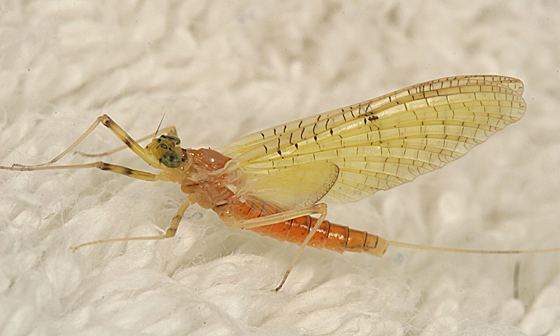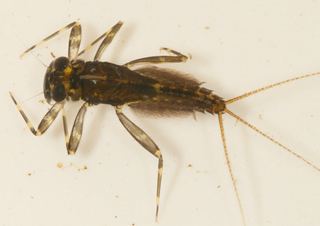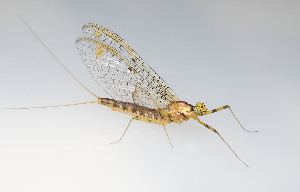Order Ephemeroptera Superfamily Heptagenoidea Scientific name Stenacron Rank Genus | Suborder Schistonota | |
 | ||
Similar Mayfly, Stenonema, Heptageniidae, Insect, Maccaffertium | ||
Stenacron comadidum mayfly ecology documentary
Stenacron is a genus of mayflies in the family Heptageniidae.
Contents
- Stenacron comadidum mayfly ecology documentary
- Stenacron ecology documentary part 2
- Stenacron ecology
- Brief history
- The leopard did change its spots
- References
The genus of Stenacron (Jensen 1974) is a vastly understudied and largely misunderstood genus. From P A Lewis (1974) "The Taxonomy and Ecology of Stenonema Mayflies" forward, very little to nothing has been done with this genus in the field and in laboratories.

Stenacron ecology documentary part 2
Stenacron ecology

Although the larva can be found in many different conditions they have some basic and preferred requirements. All samples I have collected regardless of the form or species are found near the bank. They tend to cling to the underside of rocks that are a minimum of 8 X 8 inches and 2 inches thick. The larger the rock the greater the population per rock. They are seldom found in the faster riffle waters but more so at the slower moving banks. Typically with a water depth of no less than 3 inches and up to 16 inches deep. The most important factor is the waters "DO" (dissolved oxygen). Stenacron can live in waters that are not moving and low in (DO). In rearing experiments I have found that they can survive and hatch in a bucket with little oxygen added for up to 4 days. However, in a watershed they do prefer a stable and moderate DO in which greater populations will occur. Lewis (1974) showed that the form (Stenacron interpunctatum / heterotarsale) historically carried an EBI (Empirical Biotic Index) rating of a level (7) showing a high tolerance level to pollution's both Toxic and Organic. (under updates)
Brief history

Dr J R Traver, the second author of the Biology of a Mayfly (1935), erected three distinct groups in the genus Stenonema in 1933. The interpunctatum group later became the genus Stenacron. Steven L Jensen in 1974 erected the genus name Stenacron.

There are currently 16 forms that reside in this genus and only 7 of the forms carry a valid species status. The other remaining forms have all been synonymized into the valid species Stenacron interpunctatum. These forms are referred to as Stenacron interpunctatum / interpunctatum not as Stenacron interpunctatum.(Say 1839)

Thomas Say, the god father of American entomology, first documented the species interpunctatum in 1839 in Indiana from 20 halotypes and 14 paratypes. Hagan (1861) confirms and expands the geographical range of the species with the collection of others in Virginia that concurred with Says (1839) halotypes.
Here is a list of the currently valid species as of 2014:
Stenacron candidumStenacron carolinaStenacron floridenseStenacron gildersleeveiStenacron interpunctatum (Say 1839)Stenacron minnetonkaStenacron pallidumBelow are the synonym forms that make up the interpunctatum complex.

The leopard did change its spots
New larva morphological information has been found! Before we review these findings let me quote a few important statements from previous authors on this genus to set the pace.
Spieth 1947; “No experimental evidence exist to indicate how much or how little coloration of the imaginal individuals of this genus is independent of the environment in which the nymphs develop. Circumstantial evidence Spieth (1938) indicates, and such evidence is constantly accumulating, that the environment may play a part in determining the degree of coloration of the adults”
Spieth 1947; “When confronted with a large series, especially from the areas around the Great Lakes, more “intermediate” than “typical” specimens are invariably found”
Lewis 1974; “Studies should be designed to ascertain whether the apparent hybrids are truly hybrids or are environmental variants within species. The influence of glaciation and biogeography on the distribution of several populations needs investigation”
This genus is without question a special one as to have created such a mystery surrounding them. So much effort was spent on the hybrid theory that the truth was never found until 2014. Recent discoveries through isolation rearing has shown all the true variations. This genus has very special qualities to it that no other to my knowledge has. There are multiple forms of larvae for one adult form. On August 26, 2014, larva were found that did not match any larva known in the genus. The adults seemed to align somewhat with Travers 1935 ohioense. Without males we could not conclude with assurance that it was that form. After reviewing 4 males the conclusion was, it is in fact a variation of the form ohioense.
Interestingly enough there are at least two distinct larvae forms that reared out to ohioense. Referring to them as the light type, that meets the criteria of the historical profile created by Traver 1935, for this form in the larva state. The other is the dark type, which is only found on very dark background substraights. The principal difference in the adults is the lack of median line, and the sub-lateral shading on the dorsal side of all tergites. The principal difference in the larvae is the discontinuous submedial abdominal stripes in the dark type, and continuous stripes in the light type.
In the adults the light type has a deletion in maculation of the median stripe making them look like a hybrid of ohioense & majus or a frontale. The dark type rears out with a complete median line. With this new information a review of all the larva forms began, to see if others possibly have this very distinct morphological trait and conjunctum, also has this substraight camouflaging trait.
Both ohioense and conjunctum type larvae were collected on Bronte creek and the two collection sites are 3.9 miles apart. The stream has a very dark bottom with blackish sediments, and is turbulent, as you go upstream to site STENO-9. And, becomes meandering with higher levels of pale clay sedimentation as you go down stream to site STENO-5. In viewing the interpunctatum group there are many different forms that make up this complex. However, the most confused forms all align with frontale rather than interpunctatum Say, from appearance to genitals.
Starting with the darkest ones that align with frontale to the lightest, from left to right, here are those forms. Referring to this as a hypothetical frontale complex.
frontale complex;
darkest-lightest; ohioense, frontale, proximum, conjunctum, and the lightest being majus, and all of them have genitals like frontale.Although there are studies that indicate other factors (McCafferty & Pereira 1984) to eliminate subspecies status, no one has been able to spend the appropriate time with each larva one on one. From the evidence here, the subspecies status should have never occurred. That was based more so on the hybrid concept than fact. As well until today little to nothing was really known about the larva which only compounds the problem. The first species found takes precedence when species are synonymized, and trying to make all these forms fit into interpunctatum is where the problem occurred. Travers 1935 information directly indicates that some of the forms have genitals that align with frontale. These forms also all look very similar to frontale in all respects. Thomas Say founded interpunctatum in 1839, Walker founded canadense in 1853, and finally Banks founded frontale 1910, all 3 should have taken precedence with synonymized species. These are also the 3 oldest forms in the genus. Truly if, and evidence shows that if Spieth erected frontale as a valid species complex, and synonymized the allied forms to it, we would not have any taxonomic confusion in this genus today. There are still forms like affine, areion, and heterotarsale that needed to be placed in the interpunctatum complex at that time, and that complex needed to be erected, as he did.
The only odd ball is canadense. It fits into the frontale complex by maculation, but by genitals it aligns more so with interpunctatum Say. Therefore, Having left this form as a valid species by its age precedence value, and more on its individuality that would have been deemed satisfactory.
With the substraight playing a role in larva maculation in both ohioense and conjunctum, and suspecting it in the other forms. My rearing plan for 2015 has been modified to incorporate this new information. The plan now is to rear of some 2000 samples under 3 substraight platforms all at room temperature. By collecting larva that are likely to hatch within a week of being placed in the tanks, the possibilities of environmental alterations are minimal.
Substraights of the Niagara Escarpment; 1: Very dark black rocks and dark soil sedimentation to represent site STENO-9 for the dark forms.
2: Moderate coloring, having lime stone rocks with red clay sedimentation with appropriate Cladophora algae levels to represent site STENO-5 for the intermediate forms.
3: Very pale background consisting of white and red clay sedimentation, to represent site STENO-2
The mouth of the watersheds for the lightest forms like interpunctatum Say and heterotarsale.
The geographical fundamentals of the Great Lake region are. All streams or rivers that flow from the Niagara Escarpment to the Great Lakes all possess these 3 basic substraight types. In their uppermost headwaters they are spring feed with dark substraights. As they fall over the Escarpment they enter the red clay plane region and become meandering in nature. Red clay bluffs become the rule, and during rains flood with red clay silt runoff. When we enter the lower basins they are completely saturated in both white and red clay sedimentation to the point that little aquatic life exist. However, with regards to Stenacron having a diet that mostly consist of mineral content it is not uncommon to find the forms heterotarsale and interpunctatum Say, where nothing else exist. By replicating their environments we can anticipate that each form should have at least 3 variable larva and adult types, that rear out with the mid range adults matching the historical profiles. This type of rearing program can help create new revealing data. It will allow for boundaries in understanding the variability to be set, in what is an acceptable variation from the true historical profile. We can surmise the following based on the new current larva evidence.
ohioense; very dark form with 3 types that represent the total forms historical profile. The lighter of the type looking very much like a dark frontale and the darkest similar to gildersleevei.
frontale; a moderate form that could have 3 types that represent the total form with the lightest variation being very much like proximum, and the darkest more towards ohioense.
proximum; one of the lighter forms in the complex that should also have 3 distinct types, the light-est looking like conjunctum or majus, the darker nearing frontale.
conjunctum; one of the lightest forms in the complex, with likely 3 different types, the light-est like majus and the darkest similar to proximum.
majus; being the lightest overall in the complex and having likely 2 distinct types, with the light-est missing pleura streaks, spiracular spots, and the median dorsal line, and looking like interpunctatum in appearance, the darker form similar to conjunctum.
Clearly with this new information and planned rearing platform we can expect there are no hybrids, but we can anticipate and document all the variable types within each form, and create expected variation boundaries. It should also then be reasonable to view all the forms allied with frontale, to be considered geographical variations of true frontale. This could mean the loss of a vital larva key that can be used to sort the forms, and species “IE” the lateral projections. This key is vital to all valid species like candidum, carolina, and pallidum that have unique spine size variations. Ohioense and proximum also have reliable lateral projection that are unequaled in size. This key is consistent and reliable to all the forms of Stenacron known.
Erecting a frontale complex with the synonym allied forms listed above, does solve all the major taxonomic problems in the genus.
Reviewing the illustrations clearly shows that 5 of the 6 forms are very close in representation of frontale as well as illustrations of genitals. Making a frontale complex is a reasonable approach to correct the genus.
References
Stenacron WikipediaCredit: Mack, A Beacon
